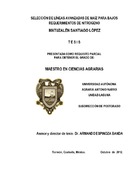Mostrar el registro sencillo del ítem
Selección de líneas avanzadas de maíz para bajos requerimientos de nitrógeno
| dc.contributor.advisor | Espinoza Banda, Armando | |
| dc.contributor.author | Santiago López, Matuzalen | |
| dc.contributor.other | Palomo Gil, Arturo | |
| dc.contributor.other | Preciado Rangel, Pablo | |
| dc.date.accessioned | 2015-10-26T18:02:28Z | |
| dc.date.available | 2015-10-26T18:02:28Z | |
| dc.date.issued | 2012-10-01 | es_MX |
| dc.identifier.uri | http://repositorio.uaaan.mx/xmlui/handle/123456789/7449 | |
| dc.description | Seleccionar líneas eficientes en el uso del nitrógeno, bajo condiciones de riego | |
| dc.description.abstract | "La Comarca Lagunera es una de las regiones agrícolas y ganaderas más importante de México, el maíz forrajero es esencial para la alimentación animal, con la utilización de híbridos a partir de cruzamiento de líneas. El manejo de la fertilización es uno de los pilares fundamentales para optimizar resultados en sistemas de explotación, es importante desarrollar metodologías adecuadas que permitan realizar un uso optimo de los fertilizantes, al aplicar dosis optimas, para tener una máxima producción y sin riesgo de contaminación. Existe estrecha relación entre el contenido de nitrógeno y clorofila en hojas de maíz. El estado nutricional del cultivo puede ser evaluado a través de la medición del contenido de clorofila de la hoja. Este trabajo tuvo como objetivo seleccionar líneas eficientes en el uso del nitrógeno. Se evaluaron cinco líneas élite, en un diseño en bloques al azar, con arreglo en parcelas divididas y dos repeticiones. A la parcela mayor se le asignó los niveles de nitrógeno (0, 100 y 200 U ha-1) y las líneas a las subparcelas. Con el medidor de clorofila Minolta® SPAD-502 se tomaron lecturas de 59 a 112 días después de la siembra (DDS). Variables agronómicas evaluadas: Días a floración masculina (FM) y femenina (FF), altura de planta (AP) y mazorca (AM), rendimiento de forraje verde (RFV) y materia seca (RMS). Calidad forrajera, fibra detergente neutra (FDN) y ácida (FDA), digestibilidad de materia seca (DMS), energía neta de lactancia (ENL) y proteína cruda (PC). La L18 y L6 mostraron mayor lectura SPAD en los 3 niveles de fertilización. Mayores rendimientos, se encontraron con aplicaciones de 200 U ha-1, superando de forma significativa al de 0 y 100 U ha-1. En RFV lo obtuvieron L18 y L6. Para RMS L18, L6 y L8. Además, las líneas mostraron alta calidad forrajera, siendo mejor la L8." | es_MX |
| dc.format | ||
| dc.language | Español | es_MX |
| dc.publisher | Universidad Autónoma Agraria Antonio Narro | |
| dc.rights | Acceso Abierto | |
| dc.rights.uri | CC BY-NC-ND - Atribución-NoComercial-SinDerivadas | |
| dc.subject | CIENCIAS AGROPECUARIAS Y BIOTECNOLOGÍA | |
| dc.subject.other | Zea mays L | |
| dc.subject.other | Líneas | |
| dc.subject.other | SAPAD-502 | |
| dc.subject.other | Rendimiento | |
| dc.subject.other | Nitrógeno | |
| dc.title | Selección de líneas avanzadas de maíz para bajos requerimientos de nitrógeno | es_MX |
| dc.type | Tesis de maestría | es_MX |
| dc.description.abstractEn | "The Laguna Region is one of the regions most important agricultural and cattle from Mexico, corn fodder is essential for animal feed, with the use of hybrids from crossing lines. The fertilization management is one of the fundamental pillars to optimize results in operating systems, it is important to develop appropriate methodologies that enable optimal use of fertilizers, applying optimal doses, for a maximum production without risk of contamination. There is close relationship between nitrogen and chlorophyll content in corn leaves. The nutritional condition of the crop can be assessed through the measurement of the chlorophyll content of the sheet. This study aimed to select efficient lines of nitrogen. Five elite lines were evaluated in a randomized block design with split plot arrangement and two repetitions. The main plot was assigned nitrogen levels (0, 100 and 200 U ha-1) and the lines to the subplots. With chlorophyll meter SPAD-502 Minolta® readings were taken from 59 to 112 days after planting (DAP). Agronomic variables: Days to flowering male (FM) and female (FF), plant height (AP) and cob (AM), green forage yield (RFV) and dry matter (RMS). Quality forage neutral detergent fiber (NDF) and acid (FDA), dry matter digestibility (DMD), net energy for lactation (NEL) and crude protein (CP). The L18 and L6 showed higher SPAD reading at 3 levels of fertilization. Higher yields were found with 200 U applications ha-1, significantly surpassing that of 0 and 100 U ha-1. In RFV L18 and L6 got it. For RMS L18, L6 and L8. In addition, the lines showed high forage quality, better still L8." | es_MX |
| dc.type.version | Versión publicada | |
| dc.audience | Estudiantes | |
| dc.audience | Investigadores | |
| dc.publisher.place | Torreón, Coahuila, México | es_MX |
